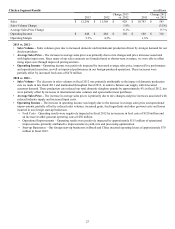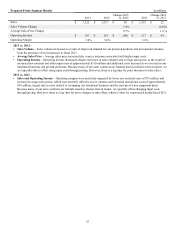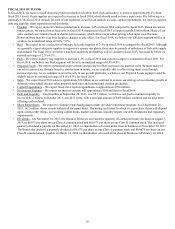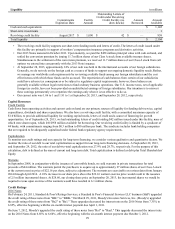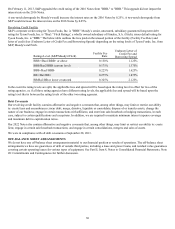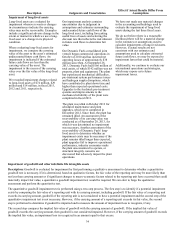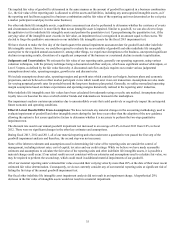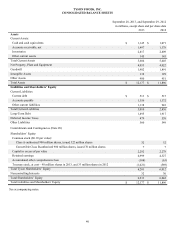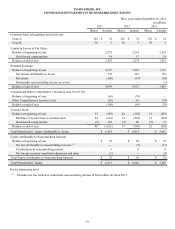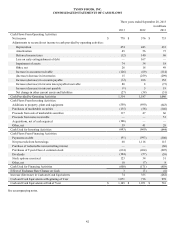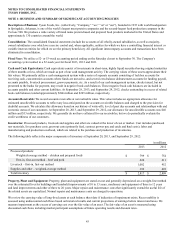Tyson Foods 2013 Annual Report Download - page 33
Download and view the complete annual report
Please find page 33 of the 2013 Tyson Foods annual report below. You can navigate through the pages in the report by either clicking on the pages listed below, or by using the keyword search tool below to find specific information within the annual report.
33
Description Judgments and Uncertainties Effect if Actual Results Differ From
Assumptions
Accrued self-insurance
We are self insured for certain losses
related to health and welfare, workers’
compensation, auto liability and general
liability claims.
We use an independent third-party actuary
to assist in determining our self-insurance
liability. We and the actuary consider a
number of factors when estimating our
self-insurance liability, including claims
experience, demographic factors, severity
factors and other actuarial assumptions.
We periodically review our estimates and
assumptions with our third-party actuary
to assist us in determining the adequacy of
our self-insurance liability. Our policy is
to maintain an accrual within the central
to high point of the actuarial range.
Our self-insurance liability contains
uncertainties due to assumptions required
and judgment used.
Costs to settle our obligations, including
legal and healthcare costs, could increase
or decrease causing estimates of our self-
insurance liability to change.
Incident rates, including frequency and
severity, could increase or decrease
causing estimates in our self-insurance
liability to change.
We have not made any material changes
in the accounting methodology used to
establish our self-insurance liability
during the past three fiscal years.
We do not believe there is a reasonable
likelihood there will be a material change
in the estimates or assumptions used to
calculate our self-insurance liability.
However, if actual results are not
consistent with our estimates or
assumptions, we may be exposed to gains
or losses that could be material.
A 10% increase in the actuarial estimate at
September 28, 2013, would result in an
increase in the amount we recorded for
our self-insurance liability of
approximately $11 million. A 10%
decrease in the actuarial estimate at
September 28, 2013, would result in a
decrease in the amount we recorded for
our self-insurance liability of
approximately $17 million.
Income taxes
We estimate total income tax expense
based on statutory tax rates and tax
planning opportunities available to us in
various jurisdictions in which we earn
income.
Federal income tax includes an estimate
for taxes on earnings of foreign
subsidiaries expected to be taxable upon
remittance to the United States, except for
earnings considered to be indefinitely
invested in the foreign subsidiary.
Deferred income taxes are recognized for
the future tax effects of temporary
differences between financial and income
tax reporting using tax rates in effect for
the years in which the differences are
expected to reverse.
Valuation allowances are recorded when it
is likely a tax benefit will not be realized
for a deferred tax asset.
We record unrecognized tax benefit
liabilities for known or anticipated tax
issues based on our analysis of whether,
and the extent to which, additional taxes
will be due.
Changes in tax laws and rates could affect
recorded deferred tax assets and liabilities
in the future.
Changes in projected future earnings
could affect the recorded valuation
allowances in the future.
Our calculations related to income taxes
contain uncertainties due to judgment
used to calculate tax liabilities in the
application of complex tax regulations
across the tax jurisdictions where we
operate.
Our analysis of unrecognized tax benefits
contains uncertainties based on judgment
used to apply the more likely than not
recognition and measurement thresholds.
We do not believe there is a reasonable
likelihood there will be a material change
in the tax related balances or valuation
allowances. However, due to the
complexity of some of these uncertainties,
the ultimate resolution may result in a
payment that is materially different from
the current estimate of the tax liabilities.
To the extent we prevail in matters for
which unrecognized tax benefit liabilities
have been established, or are required to
pay amounts in excess of our recorded
unrecognized tax benefit liabilities, our
effective tax rate in a given financial
statement period could be materially
affected. An unfavorable tax settlement
would require use of our cash and
generally result in an increase in our
effective tax rate in the period of
resolution. A favorable tax settlement
would generally be recognized as a
reduction in our effective tax rate in the
period of resolution.


